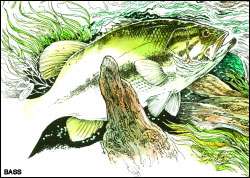
The common thread of fishing rivers, streams and tidal bass fisheries is undeniably the presence of moving water. In the case of rivers and streams, the water generally flows in one direction.
For tidewater zones, influenced by the daily rise and fall of water known as the high and low tide, the opposite situation holds true. That being the case, finding yourself at the right place at the right time is more critical with tidal bass fishing than any other form of freshwater angling.
For example, a grass flat in a river 30 miles away from the sea may hold a tournament-winning limit of bass in early morning, but by midday the place is dead because the river is flowing in the opposite direction.
The bass have disappeared and you might find yourself running aimlessly in search of the fish — unless of course, you knew when to be there. In tidal bass fishing, timing is everything — and good timing revolves around the tide cycle. A tide is created by how the sun and moon affect the gravitational forces of the earth. As a result, the water rises and falls in cycles ranging from 12 to 24 hours. Tides also create current, which by definition is the lateral flow of water. In tidal rivers, strong rising tides from the ocean push against river water flowing in at the coast.
Consequently, tidal inflow can back up the largest rivers to such an extent that their freshwater flowage is reversed for well over 100 miles from the coast until the tide begins falling. Fortunately, tides and resulting currents are predictable.
Coastal anglers, like Bobby Barrack, plan their fishing trips around the ebb and flow of the tide even before checking the weather. Barrack, a trophy bass guide at California's San Joaquin River Delta, specializes in trophy bass trips to what is undeniably the nation's premier tidewater largemouth fishery. With the tide providing the foundation for tidal bass fishing, Barrack adds the element of water temperature when formalizing his strategy.
"As a general rule, the high tide is superior to the low tide for quality fish when the water temperature is below 63 degrees," he observes. "Above that temperature range, you will catch bigger fish on the low tide." In early spring, Barrack explains, fish confined to a concentrated area on a low tide — such as a river
channel — for extended periods, will venture into inundated areas on the high tide because their food source has been expanded. There are literally more choices and more space to search for food, and as a result, the fish become aggressive feeders.
As the season progresses, the low tide becomes the place to be — simply because river currents and deep water provide both comfort and a food source for the fish. This is not to say the fish will avoid shallow water during summertime. They will just be more aggressive in deep water and on the low tide because of the availability of current and food.
"On the low tide, the forage fish move into deeper water and become an easier target," explains Barrack. "The food source becomes concentrated in one place, such as a river channel, and the fish will congregate there to feed on the bait." Many tidal rivers have sharply defined edges, which are premier bass holding areas that Barrack targets when the tide is low.
Tidal bait for big bass The window of opportunity is small, but the dividends can be well worth the effort. That is how tidal expert Bobby Barrack explains summertime frog fishing to his guide clients. One thing is a given when fishing a frog, he says. "You are fishing for one bite. That may be the only chance you have for a big fish. So you've got to be focused 100 percent of the time on 'executing' should that bite occur." Barrack says the biggest mistake his clients make is not keeping a tight line when the fish has eaten the frog.
Most fish are lost when the angler drops the rod to set the hook on the fish, he says. "You've got to reel down on the fish and keep the line tight," Barrack explains. "You just can't leave any slack in the line with a frog, or the fish will get off."




